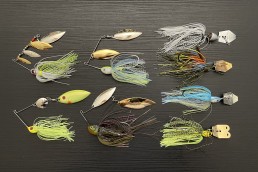Battle of the Blades!
SHARE THIS POST
Dan Brozowski discusses the pros and cons of spinnerbaits vs. blade baits.
By the words suggested in the title, it would seem fitting to have a tuxedo-clad ring announcer introducing two opponents, “In this corner, the venerable one-time favorite Flash Sensation, the Spinnerbait—and in the opposite corner, the new Sensation, the Heavy-Thumping Bladed Jig!” Let the battle begin!
Okay, a little more drama than is necessary for the topic of spinnerbaits vs. bladed jigs, but I often receive questions, on an either/or choice basis of which bait is a better. W while I hate to pass on a debatable subject, I honestly admit to no clear winner here.
I can see how the two baits can become somewhat linked as baits sharing a similar category. They both have jig-like bodies on the hook end, flash or vibrating metal attachments that add both a visual attraction as well sound-attracting distinction to the bait. But honestly, they are two very different bait categories, at least in my eyes.
Let’s look at them both, then you make the call! The spinnerbait here I’m referring to is what we once called the “safety pin type”—yikes, I’m showing my age—but it certainly differs from the in-line spinner in design. Today’s anglers are a probably a bit more familiar with the contemporary design of spinnerbait, categorized as a wire bait. They are just that—a wire-formed bait sporting a multitude of metal blade types, various colors and finishes, numbers and sizes of blades, all creating their own distinctive flash and vibration. The hook end can vary as well, but rubber or silicone skirts in a variety of colors are the primary tantalizing body style.
Jump to the “newer kid on the block.” The bladed jig does have a metal blade up front; these blades also have different finishes color-wise and varying blade size options. The hook end is basically just a jig, similar to a flippin’/pitchin’, swimming type jig, with and without a weed guard and normally a silicone or rubber skirt.
If you lay the spinnerbait and the bladed jig side by side, appearance-wise, they do look like they’re from the same gene pool of baits. But action-wise and choice of purpose, they’re two very different creatures. Let’s make a few casts here; you can make your choices from there.
Spinnerbaits, while a year-round choice, have in the past been a choice for springtime and colder water; they seemed to be one of the first baits to come out of the tackle box after a long winter hibernation, and with good reason. You can work the bait at various depths, and slow-roll them even in the coldest water conditions with positive results. As the waters warm, you can adjust bait weights, and change up blade types and finishes for varying flash patterns and sound output.
Are you enjoying this post?
You can be among the first to get the latest info on where to go, what to use and how to use it!
Moving to the bladed jig, it does not have as much in the ability to adjust the flash as the spinnerbait. But by adjusting the bait blade and body size, these slight variances can change the effectiveness of this bait both, visibly and sound- and vibration-wise. While both baits are normally used with some type of trailer, these additions can considerably change either bait’s action, though I believe the bladed jig is much more affected by using a variety of tail options.
I use both these baits in a wide variety of circumstances and conditions, which doesn’t help with the questions, of course, so I’ll narrow down a few basic thoughts in my fishing situations.
Spinnerbaits—I like them in a bit clearer-water conditions, although they can certainly put out quite a bit of vibration depending on the blade type used. I choose spinners because of the flash put out by the different blade types. They are significantly toned down in sound from bladed jigs, and I’ll use them when the bite is slow.
Bladed jigs—My favorites when the water is a bit murkier, these baits have an incredible sound and vibration broadcast and are easy for fish to track down in low-visibility conditions. In a bit clearer water, these baits have many visual options by changing the trailers from obnoxious to subtle—a great advantage when trying to dial in the mood of the fish for the day.
Spinnerbaits and bladed jigs should be viewed and used as their own entities of baits; they are not variations of a particular type of bait, and both have a place in today’s angler’s rotation.
So, the winner of this battle? Well, I’m going to have to call the dreaded “Draw!”
Get better results from the time you spend fishing. Use information from the pros found in every issue of MidWest Outdoors, available by subscribing on our website.
MWO
SHARE THIS POST
You may also like...
Nothing found.
Did you enjoy this post?
You can be among the first to get the latest info on where to go, what to use and how to use it!
Dan Brozowski
Passion for angling drives Dan Brozowski to the water’s edge virtually any chance he gets. Although passion cannot be measured, weighed, or recorded, it can be shared. He does this through his writing and while on the water. If you have any questions or comments for Dan, you may contact him at: onthebank@att.net.
